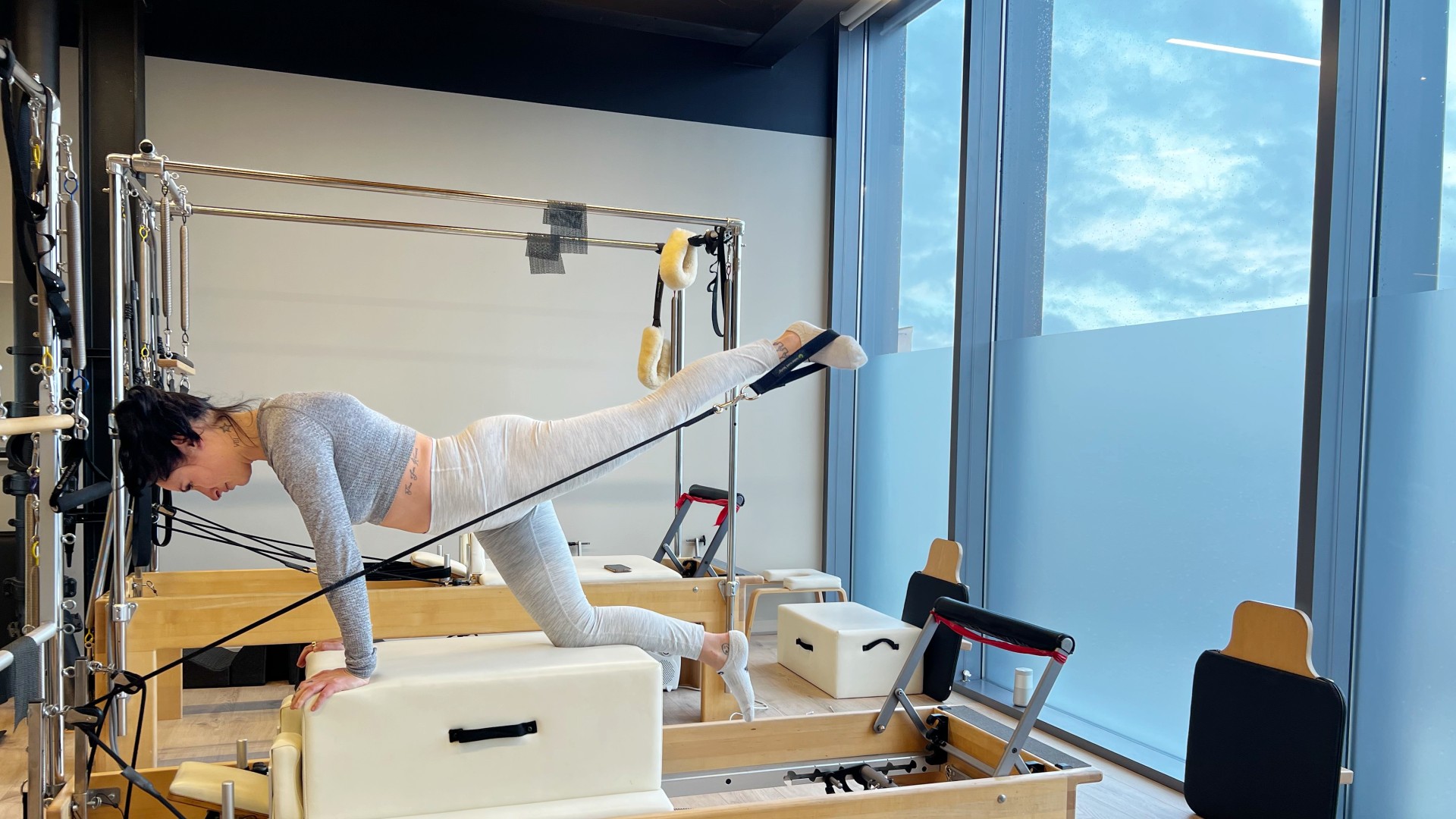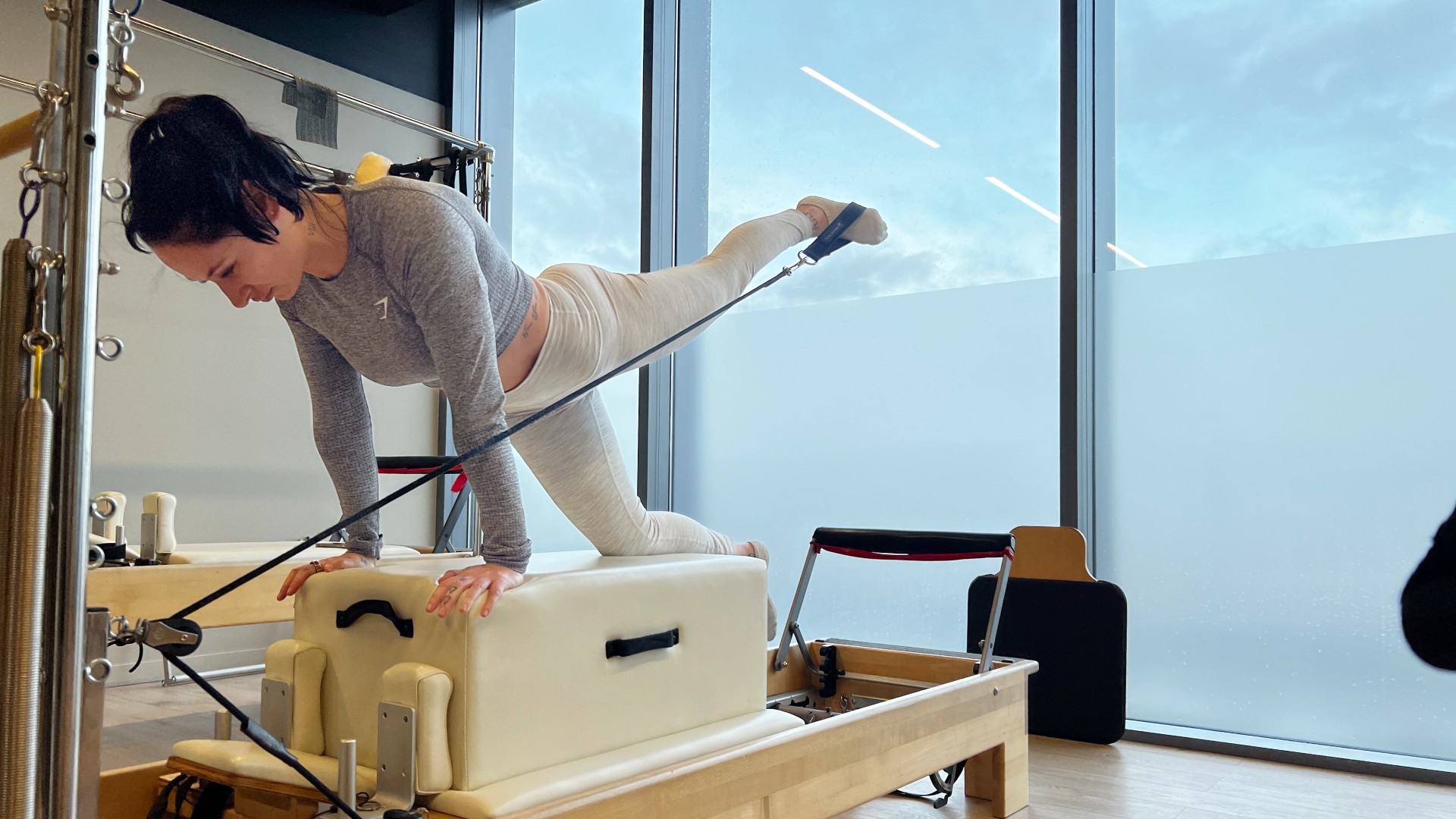
Considering just how popular Reformer Pilates is — and how much I bang on to clients about trying yoga and Pilates — it always surprises me that I hadn’t tried reformer sooner. Interest piqued, I headed to my first reformer Pilates class. And wow.
I joined forces with the Pilates In The Clouds team for a 50-minute reformer class designed to test my abs, arms and glutes. While the reformer Pilates machine looks more like a weapon of torture than fitness equipment (I mean, it kind of is), the benefits of reformer Pilates far outweigh the shaky muscle fatigue afterward.
The reformer is a brilliant way of developing a strong core, strengthening muscles in your hips, quads, glutes, and shoulders. It's also great for building power, flexibility, balance and better posture. It’s a low-impact full-body workout to build a more functional and efficient engine, and regular practice can even improve the quality of other workouts like strength training.
With that in mind, I headed up into the clouds for my first-ever reformer Pilates class. Here’s what happened.
A post shared by Pilates In The Clouds (@pilatesintheclouds)
A photo posted by on
What is reformer Pilates?
Unlike mat Pilates, reformer Pilates uses a large frame-like structure with a sliding bed called a “carriage” that you can lay or stand on. Various coiled springs attach to the carriage to add intensity through resistance to Pilates exercises, alongside various pulleys and handles that diversify the workout further by working your entire body.
It’s a versatile bit of kit hitting most of your muscles. Moreover, aerial Pilates classes utilize the frame to allow you to hang from the bed using the pulleys and ropes to challenge your balance and strength. If you prefer to stay upright or at-home Pilates and mat Pilates is more your thing, I tried this bodyweight Pilates ab workout for abs and glutes, and it’s seriously tough.
Benefits of reformer Pilates
Pilates classes improve the control and quality of your movements by working your joints and muscles through their full range of motion to build stability, strength, and better posture.
Get instant access to breaking news, the hottest reviews, great deals and helpful tips.
I’m not entirely new to the Pilates concept, having tried mat Pilates several times, but it’s never clicked for me before — until now.
During a reformer Pilates class, there’s nowhere to hide. Your muscles work under constant resistance through the shortening of the muscle called the “concentric contraction” phase of an exercise and the lengthening of the muscles during the “eccentric contraction” phase.
For example, during a horizontal squat using the reformer (think hack squats but laying down) your muscles are met with resistance as you push away to straighten your legs (concentric contraction) and as you rebend your knees (eccentric contraction) to control the movement.
You can develop stronger, more toned muscles and stabilize your core muscles and joints by practicing reformer Pilates, also fatiguing the muscles through endurance-based exercises. Deep stretches, lunges, or core exercises — you name it, Pilates tackles it. Although Pilates for weight loss is more complex, the research on Pilates supports a regular Pilates routine for managing weight, building strength, and improving flexibility.
I tried reformer Pilates — here’s what happened to my body

I gave reformer Pilates a go, and here’s what I noticed.
1. I’m a Pilates convert
I’m not entirely new to the Pilates concept, having tried mat Pilates several times, but it’s never clicked for me before — until now. Reformer Pilates adds scaleable resistance and intensity, firing up your muscles to control your movements, the carriage and the handles.
At first, It was a lot to get used to, and I could feel my balance and coordination being tested at every turn. You don’t need all the springs attached to feel the burn either, as I quickly learned in the first five minutes on the reformer. Most importantly, it was fun. I enjoyed working my body in an alien way, like practicing double-footed mountain climbers by holding on to the end of the bed and sliding the carriage up and down using my feet.
2. It’s not "just stretching”
A bugbear of mine is the misconception that yoga or Pilates is “just stretching, right?” Wrong. Wrong. Wrong. There’s undoubtedly an element of stretching and mobility work involved in reformer Pilates and yoga (that’s why we love it!) and it’s a brilliant option for injury rehab, but "low-impact" doesn’t signal “easy.” Far from it, in fact.
Reformer forces you to slow down each exercise and focus on the quality and control of your movement, working muscles through high reps for longer periods — known as endurance training. I found myself hobbling out with the familiar feeling of shaky legs afterward, as from doing heavy squats in CrossFit classes — it’s just teaching your muscles to work differently.
That said, studies like this one by Postgraduate Medical Journal found that Pilates-based exercise is effective in treating lower back pain and improving mobility, so it's doing some good.
3. My core was on fire
I often program my core workouts, but I also swear by adding the Pallof press into your routine or trying this at-home Pilates ab workout to develop your core. You can move those aside for a second because reformer Pilates is a real core torcher.
Variations of leg raises included putting my feet through the stirrups and performing large circles with my feet in opposite directions. Then, I had to start in a deadbug position (knees up at 90 degrees) and push my feet away to extend my legs. Plenty of exercises followed (and felt never-ending) but fired up all my core muscles, including my lower abs and obliques (located on the sides of the torso).
Verdict
I admit it, when I heard “Pilates in the clouds,” I thought I’d be hanging upside down like a bat in an aerial Pilates class. I’ve seen these unsparing classes on social media and thought I was headed for the same fate. It turns out that it simply refers to the company and class location — whoops. In hindsight, I’m relieved I got to test a beginner reformer Pilates class first.
They’re great for stripping it back to basics and learning how to use a Pilates reformer bed to maximize your results while building your technique from the ground up. I got to test out what resistances work best for my experience level and play around with exercises in a small group, which means I’ll be much more comfortable next time — and when I hunt down aerial Pilates soon.
Next up: Our fitness editor did Pilates every day for a month and these are the 8 best Pilates exercises to target your core.

Sam Hopes is a level 3 qualified trainer, a level 2 Reiki practitioner and fitness editor at Tom's Guide. She is also currently undertaking her Yoga For Athletes training course.
Sam has written for various fitness brands and websites over the years and has experience across brands at Future, such as Live Science, Fit&Well, Coach, and T3.
Having coached at fitness studios like F45 and Virgin Active and personal trained, Sam now primarily teaches outdoor bootcamps, bodyweight, calisthenics and kettlebells.
She also coaches mobility and flexibility classes several times a week and believes that true strength comes from a holistic approach to training your body.
Sam has completed two mixed doubles Hyrox competitions in London and the Netherlands and finished her first doubles attempt in 1:11.
